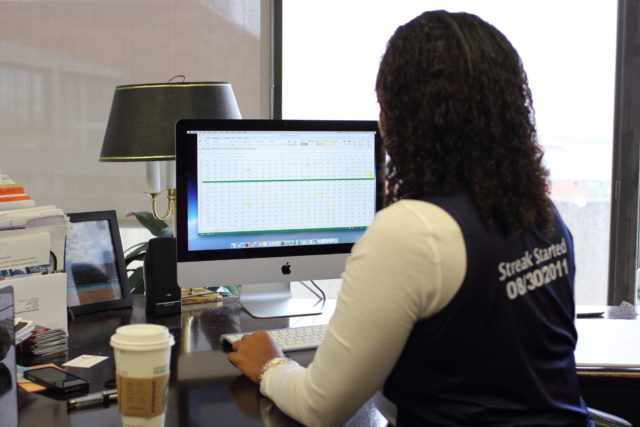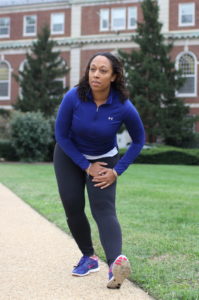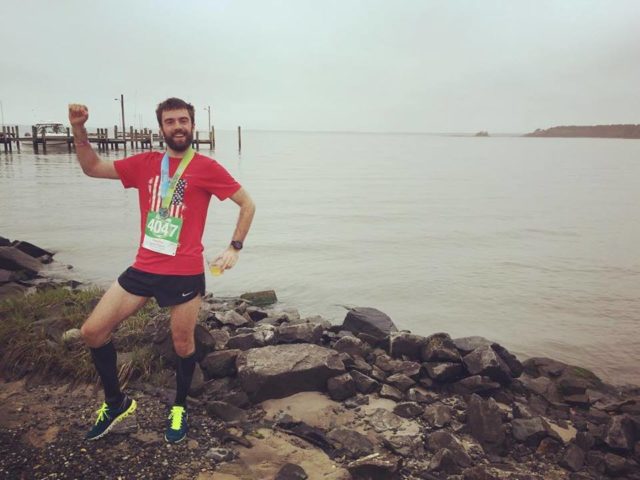
Laura Jack remembers what she wasn’t doing on Aug. 29, 2011.
She wasn’t running.
Jack can never forget that because the next day was the start of a running streak that has yet to end.
She’s on a roll. Her running streak has stretched beyond five years, and if it’s in her power, has no end in sight.
Jack started running in 2003 as a form of therapy after her father, a sprinter, died.
“I read an article about streakers and started my streak to see if I could do one year,” she said. “One year turned into two, and then into three. Now that I have hit five years, I can’t imagine stopping. It has become a regular part of my routine, like brushing my teeth or washing my face.”
She’s not alone, though she’s a relative newcomer to the approach. Englishman Ron Hill ran daily for 52 years and 39 days, starting in 1964, the year he ran in his first Olympics and broke his first world record. His steak ended Jan. 29, 2017.
Many streakers, though not all, maintain records with the United States Running Streak Association (USRSA), which sets the standard of completing one mile per day on any terrain, treadmill included. Kensington runner Jim Hage’s name isn’t on there, but he’s been going since 1982.
Jack’s job as vice president for development and alumni relations at Howard University puts her on the road a lot, making things difficult. A delayed flight forced her to miss a scheduled evening run and nearly broke her streak.
When her plane, originally scheduled to arrive in D.C. at 7 p.m., did not land until close to midnight, she had to find a way to get it in.
“When we landed, it was after 11:30, so I knew I wouldn’t make it home (in time),” she said. “I headed upstairs to the U.S. Airways lounge, thinking I could convince them I was not crazy and to let me run in the lounge. It was closed, so I put my bags down, and ran up and back in front of the lounge until I made one mile.”

Reston resident John Byrne’s almost-22-year streak nearly came to an end recently in Puerto Rico, when he broke his right arm.
“I spent hours in [the] ER,” he said. “Doctors said no exercise and I said, ‘That is not an option.’ So [I] slowly ran on a treadmill for about seven days.
A few of the longest streaks are held by women. “I hope to join that elite group one day,” Jack said.
The USRSA was founded in 2000 by Dawn and John Strumsky from Millersville, Md. They have since retired, but the organization remains strong and growing.
Mark Washburne, president of the USRSA, has run at least three miles a day since December, 1989, and his job involves maintaining data on recognized streakers. He views this responsibility as another history project, preserving these records for future generations.
He said more and more runners are starting their streaks each year. Not only is the USRSA list growing in overall number, but also in diversity. Washburne sees more women joining the list than ever before. The list has historically been dominated by male runners.
Jack hopes to be one of the women in it for the long haul. She’s noticed they’re relatively scarce, though their ranks are growing.
Streaking, of course, comes with its own set of challenges.
Runners know it can be helpful to take a day off from time to time, especially when dealing with injuries.
Washburne passed out during the Richmond Marathon and was immediately hospitalized. He went out and ran four miles the next day, which was nothing, he said, compared to one guy who ran through the hospital halls with his IV.
That might sound crazy to some, but for Washburn, it’s not surprising. He said runners have to adapt to maintain their streak. “We change the question from, ‘Will we run?’ to ‘How do we fit it into the day?’”
Strumsky wrote that simply adjusting distance and intensity should allow a runner’s body to recover while still being able to run each day.
He recommends running on a regular basis for at least six months before starting a streak, and he highlights the need for record keeping.
“Maintenance of a running log or training diary to record your activities will provide you with a record of where you’ve already been,” he said. “It will also serve as a roadmap to where you are going. There is no way to build improvement into your program if you have no means of measuring your past efforts.”
Confidence from looking back on a long streak has been a boon to D.C.’s streakers.
Running has now become a huge part of Jack’s life. It’s as much of a routine as getting dressed in the morning. She said there’s more to it than just getting a run in.
“I think the biggest takeaway is that we are stronger than we think,” she said. “Ten years ago, if you would ask me if I thought I could do this, I would say no way. I’m not the strongest person, I’m not the fastest person, I’m not the fittest. But I am strong in my own right. I would say find what you love, whether it is running or something else, and go for it with all your heart.”
For Byrne, streaking is about more than just getting in the miles. It’s about getting in the right mentality.
“A streak obviously demands a certain amount of organization and planning. It has taught me that I can use that skill in other pursuits,” he said.
Springfield’s Ben Emmons agreed that running every day puts him in a good state of mind.
“No matter how busy you are, you have time to do anything you make a priority,” he said. “Running can cure bad moods.”
He used to see running as a punishment, not a privilege. But reaching 321 pounds in 2007 told him he was living on borrowed time.
He started with short, slow distances, even prioritizing downhill runs when he could. As time went on, he quickly discovered his love for running and began pushing himself more and more in the sport. He upped his mileage and speed until he was competing in 20-plus mile races across the world.
“After visiting Paris and braving the freezing temperatures, ice and snow, and then Scotland running the 7 Hill Challenge solo, I decided I should just keep running every day for the upcoming year.”
That was December 2008. Since then, his streak has become part of his life.
“One of the more memorable days of my streak was on the day of my father’s funeral. I remember running, praying, and crying all at the same time … that run helped me process so much. Days with runs like this have made me realize that the trick isn’t keeping the streak going during tough times, but rather that the streak keeps me going through tough times.”
The beauty of streaking is that anyone can do it. There are no qualifying times, no lengthy distances to complete, nor entry fees. Whether you’re an elite runner or a beginner, everyone has an equal opportunity to start streaking. Emmons gets it.
“Sometime between when I started streaking and now, I realized running isn’t something you have to do, it is something you get to do,” he said. “It is a gift. Now I run because I can.”
Though maintaining a streak comes with its own set of risks and efforts, the streakers themselves seem to think it’s worth it.
“I never encourage people to start run streaking,” Emmons said, “but I have never met anyone who regretted it once they started.”
This article originally appeared in the Winter 2016 issue of RunWashington
Andrew Gates spends days managing Potomac River Running’s Burke store (near Burke Lake, which he chronicled in 2018) and writing running for RunWashington since 2016 and science fiction for himself (and others).
Read more of his writing here.
Name: Andrew Gates
Self-described age group: Upper 20s
Residence: Arlington, Va.
Occupation: Manager of Potomac River Running – Burke
Why you run: I enjoy it and it’s always fun to see myself improve. It’s a fun and healthy hobby.
When did you get started running: I ran competitively as far back as middle-school, but didn’t really take it seriously until I was a sophomore or junior in high school. After I turned 18, and was finally old enough to sign the waiver, I signed up for my first marathon, the Philadelphia Marathon. My first time wasn’t great – 3:38, though I have since run worse.
Have you taken a break from running: I spent several months in Germany in 2014 and took a break from running then. That was easily my longest break, though I do take period breaks from time to time never usually more than a few months tops.
Training shoe: On CloudFlow
Coach or training group: I prefer to run solo.
The hardest race you’ve ever run: The 2012 Caesar Rodney Half Marathon in Wilmington Delaware. It was terrible rain that day with really bad conditions. It was also my first time running the half-marathon distance (though I’d already done a full marathon before that). Anytime running a new distance, there is always a bit of a learning curve. I remember my feet were so insanely covered in blisters at the end of that. It didn’t help that it was a net uphill course too.
Most adventurous decision you’ve made with your running: My buddy and I had a contest in 2018 on who could do these crazy running challenges and see who would drop first. We did things like run across all state lines in DC, MD, and VA all in one run, or run barefoot, things like that. Meanwhile we were doing our regular race training through all of that too. You can read about that here.
Running mentors: I was very fortunate to have met Steve Sinko when I was a high school runner. He is the one who first got me interested in the sport. He is an awesome runner doing great things, You can read about him here.
My favorite place to run in the D.C. area is: C&O Canal Towpath/Fletcher’s Cove area
Favorite local trail: C&O Canal Towpath or Capital Crescent Trail or Mt. Vernon Trail
My best race was: Either the final race in the 2013 Crystal City 5K series or the 2013 Delaware Marathon about week after that
Favorite local race: Parks 10K or Clarendon Day 10K
Ideal post-run meal: Cheesesteak
Favorite flavor of gel, gu, etc: I prefer CliffBloks
Pet peeve: Runners who use headphones. If I were made dictator of the world, the first thing I would do is outlaw running while wearing headphones. Also, tourists who take up the entire sidewalk.
Goals: My goal is to try some different events. I did a Spartan Race in 2018 and loved trying something new and different. That was my first foray into OCR and I would be interested in trying it again. I also want to do an Ultra-Marathon eventually.
Your advice for a new runner: Don’t overexert yourself at the start.
Song in your head during a run: Back in 2013, I swear my normal running stride matched the exact beat of “Wrestled a Deer” by Johnny No Light. Every single time my feet started going, I would think of that song. But I guess my normal pace has changed. Since then, it’s a mixed bag.
Have you dealt with a major injury: I had a problem with my knee in the summer going into fall of 2014, which made me drop out of the Marine Corps Marathon. It took me a long time to recover from that.
Running quote: “Whooh, whooh!” – Brian McElhaney
Why is the D.C. area a great place to be a runner: Variety of running locations, quick and easy access to trails, and a city catered to pedestrians.
Random side-note: I was doing a tempo run in Tenleytown once when a squirrel ran from one side of the sidewalk to the other, perpendicular to me. This squirrel ran across and found itself directly on top of my right foot as it was planted on the ground. Since I was doing a tempo run at the time, I was going pretty fast, and I lifted my foot up to take another step and ended up launching this squirrel into the air probably about three feet high and three feet far until it collided against a cement wall (this was all inadvertent by the way). Thankfully it got back up and scurried away, so I didn’t kill it. But now I can tell people I’ve punted a live squirrel.


